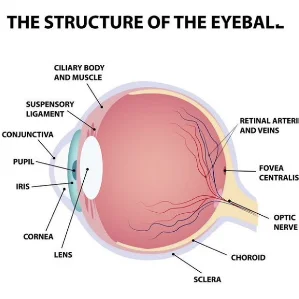 February is known for many things, like periodic Leap Years and Valentine’s Day–but did you also know that February is Age Related Macular Degeneration Awareness Month? That may sound like a mouthful, but this is an important eye condition worth understanding. Vision loss–whether in one or both eyes–is a devastating predicament for many people. However, age related macular degeneration can be especially discouraging.
February is known for many things, like periodic Leap Years and Valentine’s Day–but did you also know that February is Age Related Macular Degeneration Awareness Month? That may sound like a mouthful, but this is an important eye condition worth understanding. Vision loss–whether in one or both eyes–is a devastating predicament for many people. However, age related macular degeneration can be especially discouraging.
Let’s break down what macular degeneration is, and how age plays a role in its occurrence.
What Is Macular Degeneration?
Age Related Macular Degeneration (AMD) is a leading cause of vision loss for people aged 50 and over. It is a condition that damages the central retina (known as the macula of the eye), which affects your ability to see both near and far, thus encumbering your ability to perform daily tasks.
AMD is also the leading cause of blindness in the US for people over the age of 60. The chances of developing Age Related Macular Degeneration increase with age. For example, people over the age of 90 have a 50% likelihood of being affected by some form of AMD.
It is important to note that AMD affects central and fine visual acuity, but peripheral and side vision usually remain functional. Even in more severe cases of Age Related Macular Degeneration, patients are typically able to care for themselves adequately with sufficient vision for performing many functions. It is the smaller tasks that can be more difficult–such as reading a book, driving a car, or writing a letter.
Types of AMD
There are two types of AMD–dry and wet.
Dry Age Related Macular Degeneration (or atrophic AMD) is the most common type of Macular Degeneration. It is caused by loss of or damage to the sensitive cells beneath the retina, which then allows drusen (small yellow deposits) to accumulate. With dry AMD, vision loss usually happens gradually.
Wet Age Related Macular Degeneration (or exudative AMD) occurs when abnormal blood vessels form under the macula and begin to leak fluid or blood. This leakage is what causes blurry and/or distorted sight. Vision loss may occur severely and rapidly.
Helpful Tools to Raise Awareness
You can take steps to prevent vision loss and help friends and loved ones become educated on blindness prevention. Whether you are looking to implement tools for blindness prevention for yourself, or you want to help a friend or family member, this is the perfect month to start!
Prevent Blindness is the oldest volunteer eye health and safety organization in the US. This organization provides free resources and services dedicated to blindness prevention and raising Age Related Macular Degeneration awareness.
- Visit the AMD Learning Center for a variety of educational tools and downloadable fact sheets.
- Check out their Living Well With Low Vision program, which offers information and free materials for individuals and families of individuals living with vision loss.
The American Academy of Ophthalmology also provides a lot of educational information on Age Related Macular Degeneration. CHECK IT OUT HERE
And discover the videos and e-learning services provided by the American Foundation for the Blind by CLICKING HERE
Contact Retina Specialty Institute Today
At Retina Specialty Institute, we’re proud to offer superior eye care services for Age Related Macular Degeneration and many other conditions. We also strive to increase patient education of conditions that affect the eyes, and provide guidance on blindness prevention. If you or your loved ones are experiencing symptoms of macular degeneration, or you are concerned about vision loss in general, contact our ophthalmology and retina care practice today!






